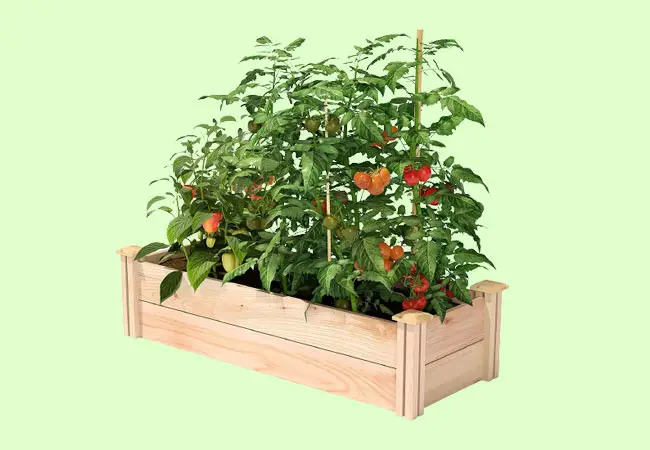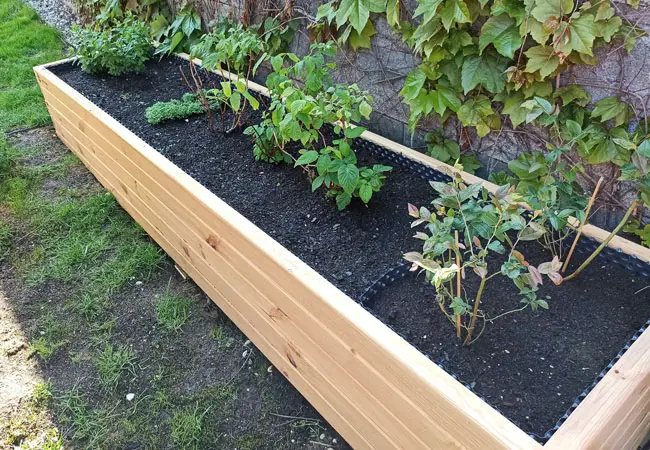There are several benefits that a raised garden offers, but they are managed a little differently than your run-of-the-mill gardens. One of the biggest questions is what you should put on the bottom of a raised garden bed.
You should have a layer of grass clippings, leaves, or other organic material at the bottom of the raised garden. This layer is basically for compost and will provide lots of nutrients for your garden’s residents. Mixing eggshells into your compost layer can give it a little extra boost.
Raised gardens are great and offer several benefits that other gardens don’t. They do, however, require knowledge and work to prepare, and there are some tricks of the trade worth noting. Continue reading, and we’ll take a look at some tricks and tips to show you how to get the most out of your raised garden.
What Do I Put on the Bottom Of a Raised Garden with Legs
For you to get the most out of your raised garden, you can’t just throw some dirt in there and call it good. A mixing process has to be employed if the garden is going to produce well, and the mix even at the bottom is an important ingredient to a successful garden.
In the very bottom of a raised garden bed, we’ll put garden waste to compost and make the soil rich with nutrients. The goal here is to use organic materials that will break down quickly. While organic materials like eggshells are super good for the soil, they don’t break down very easily.
There is, however, a way around that, and that’s to put your eggshells in a blender first. That will help them compost much quicker.
On top of that, we need a barrier to prevent weeds from taking over. We have several material options to accomplish this goal; cardboard or newspapers are the cheapest and most convenient. When putting down your cardboard, you should only use one layer. With your newspaper, you should do four or five layers.
Will Carpet Work as a Weed Barrier in a Raised Garden?
No, don’t use it. It will slow the water from draining and limit the growth of the plant’s roots, limiting the size that they’ll grow to. Another barrier option to avoid is plastic bags for the same reasons.
What Kind of Soil Should You Use in Your Raised Garden?
Ideally, you’ll do about 60 percent top-soil, 30 percent compost, and ten percent potting soil. You can substitute the top-soil with 50/50 potting soil and compost.
If you’re thinking of adding peat moss to the mixture, consider that it’s very acidic and isn’t the best for growing medium-sized veggies. So, if you’re going to use it, don’t use much more than 20 percent of the total mixture.
Here’s a quick reference guide:
- 60 percent top-soil
- 30 percent compost
- 10 percent potting soil
- If you are going to use peat, don’t exceed 20 percent of the entire mixture.
This soil mixture will help you get some nice vegetables out of your garden. Just remember to top it off from time to time.
Tip: Don’t Step on Your Soil
By stepping on the soil of your raised garden, you are completely negating the advantages it brings. Stepping on the soil compacts it, making it harder to drain, and the biggest advantage gained by having a raised garden is that you can maintain well-drained, fluffy soil. So, do yourself and your garden a huge favor and keep that soil light and un-compacted.
Don’t Forget to Top Off the Soil.
It’s important to keep in mind that raised garden soil is constantly settling. You shouldn’t be surprised if you find the soil level an inch or two lower within a season.
What does your soil look like? If it’s dry and compact as opposed to light fluffy and moist, you’ll probably need to give it a pick-me-up. Adding lime, peat, rock sulfate, or adding some compost, then covering it with some soil or mulch, will really bring your garden’s soil back to life.
Does a Raised Garden Need a Bottom?
This depends on the bed’s positioning; if your raised garden bed is sitting on the ground, then there is no need for a bottom; that’s not to say that it isn’t a good idea to put something down to stop the growth of weeds.
Putting down something to prevent weeds is actually a great idea, and it doesn’t necessarily need to be a hard bottom. You can put down weed fabric, which works just like the cardboard, preventing weeds from germinating in your garden but still allowing it to drain.
Is It Safe to Eat Veggies Grown in a Raised Garden Bed?
Since raised beds are typically made of wood, a common question is whether or not it’s actually safe to eat what you grow in them, as some types of wood sealants or finishes can be toxic.
The short answer is yes. It’s probably ok as long as you have a barrier between the wood and the soil.
The longer answer is: not always, but you can make it safe. While it’s tempting to think that the soil itself surely would be enough protection between any non-food-safe wood and the veggies, you have to remember that, when gardening, the soil is almost better seen as a liquid than a solid!
Oddly enough, nutrients and other chemicals have a way of dispersing themselves throughout the soil with the help of water, worms, other bugs, and even just the natural mixing of soil. This is why it’s important to always use a food-safe treatment or liner on any box or bed that you plan to grow food in.
If you build your own garden bed, you can buy untreated lumber and use a food-safe finish like shellac, linseed oil, or pure tung oil. If you bought a premade bin and are unsure of the finish, put a layer or two of weed fabric before placing soil inside.
Top 3 Raised Garden Beds
There are several styles of pre-built raised gardens that you can choose from. Here are three of the most popular raised gardens out there that can give you a great head start:
- Miracle Grow Cedar Raised Garden: This raised garden makes the number one spot on most reviews out there. It’s a 16 square foot box made of cedarwood. The design of this bed also allows you to expand the garden with ease. It’s just all-around easy; the biggest drawback is the price at $175 – $200.
- Grow-nomics Multi-Level Rustic Raised Garden Bed: This three-tiered garden bed is easy to assemble and requires no tools. Each wood piece slips into slots and is ready to go in minutes. The multi-level design allows you to grow several different plant varieties. Since it has three tiers, it comes in pricier at $230.
- VegTrug Patio Garden: This patio garden is built with a V-shape to house those plants that grow deep roots. It’s made of firwood and is treated with a safe finish, perfect for growing just about any vegetable you want. This raised garden is a little bigger than the others and will cost you around $300.00, but the quality is worth the price.
If you have the budget and the green thumb for it, anyone of these raised gardens will be great for you.
In Conclusion
The bottom of your raised garden should consist of a mixture of compost, soil, and cardboard. If your raised garden doesn’t have legs, then it’s not a bad idea to put weed fabric down to stop weeds from germinating in your garden. So, there you have it now, get out there and get gardening.


